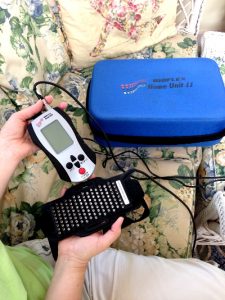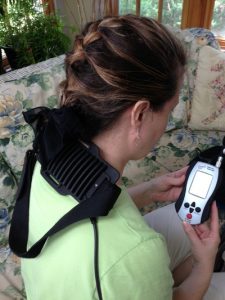- About
- Herbs
- Methods
- Issues with…
- Imbalances in…
- Client Info
- Store
Light Therapy – Photobiostimulation
Light is energy. Energy is needed to heal. Energy can penetrate into tissues to the blood, and, some tissues where blood may not be able to reach.
Visible light energy comprises a small part of the total energy spectrum. This simply means that only a small part of the whole range of frequencies of the energy spectrum is visible to the human eye.

An array of light emitting diodes is shown here in Brenda’s right hand. Her left holds the controller by which parametrs are set for the particular application.
Light therapy devices emit photons of light which are absorbed by the mitochondria of the cells. It is believed that this results in an increase in cellular energy thus healing. As of yet, no one knows exactly how these benefit human tissue but the results are demonstrable. It is also believed that every cell in the body has red light sensitive chemicals found in the mitochondria, and, when stimulated with the proper wave length of light, energy production increases and leads to healing.
Devices providing light energy are categorized according to specific characteristics of the energy they provide. Some provide columated or synchronized light and, as such, are true lasers. These can be dangerous and are classified (Classes 1, 2, 3a, 3b and 4) depending on the potential for causing biological damage. Other light devices deliver intense light (superluminous LEDs) of a more diffuse nature and have been shown to be safe and have positive therapeutic value. This latter group are called Cold Lasers, Soft Lasers, or LLLT (Low Level Laser Therapy). These are safer, easily applied and effective. They emit billions of photons which are particles of energy. These are thought to be absorbed by organelles within the cell and restore normal cell function and structures within the cell.

Here the array of IR emitting lights are placed directly on the skin and the program of light therapy is executed according to the parameters set on the controller.
LLLTs therapeutic application is determined by the wavelength (or frequency) of the light energy. Longer wavelengths (780-840nm, infrared) penetrate more deeply to affect chronic deep pain and inflammation, joint injuries and fractures, neuro degenerative conditions and nerve injuries. The visible red lights (630-700nm) have shorter wavelengths and applications for surface issues such as surface abrasions, post surgical wounds, psoriasis, eczema and skin cancer.
Treatment involves placing an array of 120 superluminous LED lights (Bioflex) over the area determined at our appointment, and directly on the skin. The IR array offers 840 nanometer light source and skin surface application is 660 nanometers. Other parameters such as the waveform, frequency, duty cycle, power and duration of treatment were also determined at our appointment.
This video describes concepts and applications.
One Response to Light Therapy – Photobiostimulation
Leave a Reply Cancel reply
Consider this…..
I have learned more from very sick people than I have from double-blind, placebo-controlled, cross-over studies. My sick clients taught me how to get them well - things that even my teachers didn't know. I have such smart clients.
** Important Warning **
Nothing on this site is FDA approved. Nothing I write here is intended to be medical advice. Follow my recommendations at your own risk. Results may vary, and blah, blah, blah. So if the required warnings have not scared you away, then you have a chance. I'm reporting here what kinds of approaches actually helped very sick people get well, AND the kinds of things that actually made them sick (and it usually isn't lack of exercise, weight, menopause or smoking - it is the underlying cause of all those things.)
** Important Posts **
- ► I Went to the Doctor and the Doctor Said…
- ► THE Technical Info on the Herbs
- ► Uh oh, what was I supposed to do when I think I’m getting sick?
- ► Fatigue: The Mother of All Disease
- ► Uh oh, my kid is sick again
- ► Childhood Disorders (ADHD, Behavior Disorders, etc.)
- ► Too Busy to do Healthy
- ► Of Drugs, OTCs and Black Electrical Tape
- ► Pat’s book – Spiritual Disciplines for Physical and Emotional Healing
In case you were wondering..
B=Breakfast, L=Lunch, D=Dinner, b=bedtime. Make sure to read What to Expect on an Herbal Program (in the Herb menu) before beginning. Dosages given are about what my clients benefit from. You may be different. Begin slowly and see how each recommendation benefits you.** Join the Discussion **
This website is a work in progress and a sharing tool. Feel free to use the comment forms to share your tried and true 'something natural'.




I have used Dr.Brian Mclarens Advancedphotonictherapy light since 2002 and have a book of experience with the issues it has resolved. He made 15 videos posted on Youtube . HE DID A GREAT DEAL OF RESEARCH . He was awarded a Nobel prize for it’s application to clear up small pox. Red Light proven and used to kill bacteria.